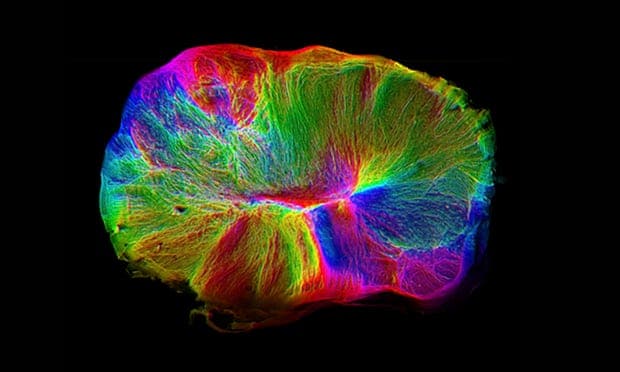
Researchers have grown a tiny brain in a dish that linked up to a mouse spinal cord and surrounding muscles. The pea-sized brain organoid sent signals to the spinal cord that caused the muscle tissue to contract, suggesting that a similar platform could be used to study motor neural diseases.
Brain in a dish
This is one of the most advanced stages of brain growth that scientists have achieved in the lab. It all started from human stem cells — basic cells that can become almost any type of cell in the body — which developed into a tiny blob. This blob resembles the brain of a 12-week human fetus in structure and variety of neurons. According to scientists at the Medical Research Council’s Laboratory of Molecular Biology in Cambridge, who led the research, the lab-grown brain organoid is made of few million neurons. For comparison, the adult human brain has up to 90 billion neurons.
Growing sophisticated tissue such as those in the human brain is rife with challenges. The biggest roadblock researchers face is supplying nutrients to the brain organoid once it matures past a certain critical phase. Previously, similar organoids would die because neurons in the center were cut off from their nutrient and oxygen supply. In the new research, British researchers cut the organoid into slices only half a millimeter thick, which they placed on a flat membrane in a nutrient-rich liquid. This configuration gave the organoid access to nutrients from below and oxygen from the air above, allowing it to develop for more than a year, reaching a greater degree of sophistication than previous efforts.
The researchers also added a one-millimeter-long spinal cord section, complete with its surrounding muscle tissue, taken from a mouse embryo to the brain organoid. The brain cells automatically linked up to the spinal cord and began sending electrical impulses that caused the muscles to twitch. The video below shows such a moment occurring.
In the future, a similar setup might be used by scientists in the field to study nervous systems and motor neuron diseases such as epilepsy and schizophrenia. Being able to answer very precise questions about what goes wrong in the context of psychiatric illness is an exciting prospect for many researchers in the field. But there is much work ahead before this can happen on a practical level.
“If getting to a full understanding of the brain is a mile, we have walked at least six inches,” Jeff Lichtman, the Jeremy R. Knowles Professor of Molecular and Cellular Biology at Harvard University, said in a statement. “You look at the actual structure of the brain or even an organoid and it’s just extraordinarily complicated. It’s much more complicated than anything humans have ever built. This is a little humbling.”
Elsewhere, at the University of Singapore, researchers have grown organoids that mimic the developing spinal cord, which can be used to investigate neurodegenerative diseases such as spinal muscular atrophy and amyotrophic lateral sclerosis.
The findings were described in the journal Nature Neuroscience.






